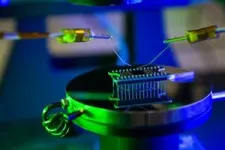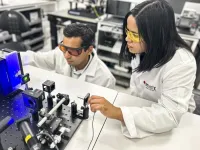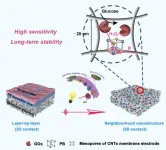(Press-News.org) NEW YORK (June 14, 2023)— Dr. Jonathan Weinsaft, an esteemed physician-scientist who focuses on clinical research and cardiovascular imaging, has been appointed chief of the Greenberg Division of Cardiology at Weill Cornell Medicine and NewYork-Presbyterian/Weill Cornell Medical Center, effective July 1.
The Greenberg Division of Cardiology, housed within the Weill Department of Medicine, is dedicated to diagnosing and treating patients with disorders of the heart and blood vessels that comprise the cardiovascular system.
In his new role, Dr. Weinsaft will further strengthen the division as a leader in scientific and technological innovation in cardiology, growing its research programs and translating these findings into exceptional patient care. He will also prioritize the training and mentoring of the next generation of junior faculty and fellows specializing in cardiovascular conditions and work to strengthen cardiovascular collaborations across NewYork-Presbyterian campuses affiliated with Weill Cornell Medicine.
“Dr. Weinsaft is an outstanding physician-scientist, a leader in his field and a dedicated mentor,” said Dr. John Leonard, interim chair of the Weill Department of Medicine and interim physician-in-chief at NewYork-Presbyterian/Weill Cornell Medical Center. “He is an ideal choice for guiding the Greenberg Division of Cardiology’s next chapter. I look forward to working with him as we continue to advance our efforts in research and patient care through collaboration with our experts in cardiology and related disciplines across our academic medical center.”
Dr. Weinsaft, who joined Weill Cornell Medicine and NewYork-Presbyterian/Weill Cornell Medical Center in 2005, is currently the Antonio M. Gotto Jr., M.D. Professor in Atherosclerosis and Lipid Research and a professor of medicine and of medicine in radiology. He also serves as director of the non-invasive cardiac imaging program at Weill Cornell Medicine and NewYork-Presbyterian/Weill Cornell Medical Center.
Dr. Weinsaft succeeds Dr. Bruce Lerman, who has led the division since 1995 and will remain on Weill Cornell Medicine’s faculty. Dr. Lerman will lead the Greenberg Institute for Cardiac Electrophysiology, where he will continue his clinical care and research activities.
Dr. Weinsaft is an expert in an array of cardiac imaging modalities, including technical development and clinical applications. He has held leadership positions in multiple cardiology programs over the last two decades, including cardiac MRI and nuclear cardiology programs that span Weill Cornell Medicine and NewYork-Presbyterian/Weill Cornell Medical Center, other Weill Cornell Medicine-affiliated NewYork-Presbyterian campuses, and Memorial Sloan Kettering Cancer Center.
“I’m excited and humbled to take on this unique opportunity to lead our world-class cardiology division, especially as Weill Cornell Medicine and NewYork-Presbyterian have been central to my career since the beginning,” Dr. Weinsaft said. “Working with our faculty, trainees and staff who are all focused on excellence is an honor and a privilege.”
As division chief, Dr. Weinsaft will collaborate with colleagues in related divisions and departments, recognizing that patients with cardiovascular diseases are treated by multidisciplinary experts in cardiology and cardiac surgery. “By fostering teamwork and collaboration between cardiovascular disciplines and among our affiliated campuses, I look forward to leading the continued growth of our clinical, research and educational programs, which are intrinsically linked and focused on improving patients’ outcomes,” he said.
About Dr. Jonathan Weinsaft
Dr. Weinsaft is a physician-scientist with over a decade-long track record of continuous extramural research support as provided by the National Institutes of Health and other agencies. He has served as principal or co-principal investigator for funded studies investigating new methods to measure blood oxygen saturation in patients with heart failure; diseases of the heart valves and how the valves respond to therapies; and understanding how the major heart artery, the aorta, responds to surgical graft replacement. He is also developing an NIH-funded training program to provide mentorship and training in basic and translational clinical cardiovascular research to trainees at Weill Cornell Medicine, Memorial Sloan Kettering Cancer Center and The Rockefeller University.
Dr. Weinsaft has authored more than 140 articles and mentored more than 100 trainees who have authored manuscripts published in leading, peer-reviewed journals. He has served in editorial positions for journals including Circulation: Cardiovascular Imaging and the Journal of the American College of Cardiology: Cardiovascular Imaging. In addition, Dr. Weinsaft has served on NIH study sections and expert consensus panels for many cardiovascular conditions. He is a member of the American Heart Association, the American College of Cardiology, the Society for Cardiac Magnetic Resonance and the National Marfan Foundation Scientific Advisory Board. An expert in his field, Dr. Weinsaft is a frequently invited speaker at leading medical institutions nationally and internationally.
Dr. Weinsaft received his bachelor’s, master’s and medical degrees from New York University. He completed an internal medicine residency and a cardiology fellowship at NewYork-Presbyterian/Weill Cornell Medical Center, followed by a fellowship in cardiac imaging at Duke University Medical Center. He then returned to Weill Cornell Medicine and NewYork-Presbyterian/Weill Cornell Medical Center, where he has served on faculty since 2005. Dr. Weinsaft holds adjunct clinical and faculty appointments at NewYork-Presbyterian Queens and Memorial Sloan Kettering Cancer Center, respectively, in conjunction with integrated program development initiatives.
Weill Cornell Medicine
Weill Cornell Medicine is committed to excellence in patient care, scientific discovery and the education of future physicians in New York City and around the world. The doctors and scientists of Weill Cornell Medicine — faculty from Weill Cornell Medical College, Weill Cornell Graduate School of Medical Sciences, and Weill Cornell Physician Organization — are engaged in world-class clinical care and cutting-edge research that connect patients to the latest treatment innovations and prevention strategies. Located in the heart of the Upper East Side’s scientific corridor, Weill Cornell Medicine’s powerful network of collaborators extends to its parent university Cornell University; to Qatar, where Weill Cornell Medicine-Qatar offers a Cornell University medical degree; and to programs in Tanzania, Haiti, Brazil, Austria and Turkey. Weill Cornell Medicine faculty provide exemplary patient care at NewYork-Presbyterian/Weill Cornell Medical Center, NewYork-Presbyterian Westchester Behavioral Health Center, NewYork-Presbyterian Lower Manhattan Hospital, NewYork-Presbyterian Queens and NewYork-Presbyterian Brooklyn Methodist Hospital. Weill Cornell Medicine is also affiliated with Houston Methodist. For more information, visit weill.cornell.edu.
NewYork-Presbyterian
NewYork-Presbyterian is one of the nation’s most comprehensive, integrated academic healthcare systems, encompassing 10 hospitals across the Greater New York area, nearly 200 primary and specialty care clinics and medical groups, and an array of telemedicine services.
A leader in medical education, NewYork-Presbyterian Hospital is the only academic medical center in the nation affiliated with two world-class medical schools, Weill Cornell Medicine and Columbia University Vagelos College of Physicians and Surgeons. This collaboration means patients have access to the country’s leading physicians, the full range of medical specialties, latest innovations in care, and research that is developing cures and saving lives.
Founded 250 years ago, NewYork-Presbyterian Hospital has a long legacy of medical breakthroughs and innovation, from the invention of the Pap test to pioneering the groundbreaking heart valve replacement procedure called TAVR.
NewYork-Presbyterian’s 48,000 employees and affiliated physicians are dedicated to providing the highest quality, most compassionate care to New Yorkers and patients from across the country and around the world.
For more information, visit www.nyp.org and find us on Facebook, Twitter, Instagram, and YouTube.
END
Dr. Jonathan Weinsaft named chief of the Greenberg Division of Cardiology at Weill Cornell Medicine and NewYork-Presbyterian/Weill Cornell Medical Center
2023-06-14
ELSE PRESS RELEASES FROM THIS DATE:
New diagnostic finds intact sperm in infertile men
2023-06-14
In a recent study, researchers created a diagnostic test to identify functional sperm in infertile men that could change the treatment of male infertility and assisted reproductive technology.
“Male infertility is a recognized issue and deserves scientific and clinical attention,” said Andrei Drabovich, an assistant professor of laboratory medicine and pathology at the University of Alberta and corresponding author of the Molecular & Cellular Proteomics study.
One in every six couples trying to conceive experience infertility issues. In fact, about 10% of men in the United States are infertile. The most ...
A novel technique to observe colloidal particle degradation in real time
2023-06-14
In the early 2000s, scientists from the UK made a worrisome discovery that the oceans are teeming with small particles of plastic (less than one millimeter in length) due to the continuous degradation of plastic waste. These microscopic particles of plastic have become a major environmental concern. Scientists classify these small particles as either microplastics or nanoplastics based on their size; the latter term is used exclusively for particles smaller than one micrometer.
These particles easily get embedded into the bodies of marine and freshwater animals, ...
Tiny device mimics human vision and memory abilities
2023-06-14
Researchers have created a small device that ‘sees’ and creates memories in a similar way to humans, in a promising step towards one day having applications that can make rapid, complex decisions such as in self-driving cars.
The neuromorphic invention is a single chip enabled by a sensing element, doped indium oxide, that’s thousands of times thinner than a human hair and requires no external parts to operate.
RMIT University engineers in Australia led the work, with contributions from researchers at Deakin University and the University of Melbourne.
The team’s research demonstrates a working device that captures, processes and stores visual ...
Solar cells can, finally, stand the heat
2023-06-14
SDE BOKER, Israel, June 14, 2023 – Photovoltaic technology is indispensable for our ability to mitigate climate change. Nonetheless, more than 70% of the energy made available to us by the sun is wasted in conventional photovoltaic cells. There is little hope for sustainable technological advancement without addressing this issue.
The operational temperature is a critical factor in a solar cell's ability to convert sunlight to free energy. Accordingly, much research has been directed toward understanding the temperature effects in the efficiency of photovoltaic solar cells. Surprisingly, ...
Scientists develop novel biosensing-membrane for glucose detection and monitoring
2023-06-14
Glucose oxidase (GOx)-based biosensors have attracted much attention for their potential in rapid glucose detection and continuous monitoring, which are crucial for disease diagnosis and prevention, as well as for controllable production in sugar-making and fermentation processes.
The glucose oxidase/electrocatalysts/electrode (GOx/ECs/electrode) cascade system serves as the core part of most glucose biosensing devices (both invasive and non-invasive). However, patterned assembly of these cascade sensing units remains challenging, thus limiting the ...
Improving word intelligibility of bone-conducted speech using bone-conduction headphones
2023-06-14
Ishikawa, Japan -- Bone-conduction (BC) headphones enhance hearing capability by generating vibrations in bone or skin close to the ear, including the regio temporalis. They simultaneously leave the ear canal open to allow the surrounding air-conducted (AC) sounds for normal hearing. However, word intelligibility – recognition ability – is often poor during bone-conducted speech perceived using BC headphones due to the attenuation of its high-frequency components, especially under noisy conditions. While inserting ear plugs in the ear canal help improve ...
Study shines new light on old drug for trauma care
2023-06-14
A new study from Australia, New Zealand and Germany published in the New England Journal of Medicine raises important questions about the success or otherwise of emergency medicine.
The study examined the drug tranexamic acid, which is commonly used to limit bleeding during surgery. However, its usefulness in emergency settings as a pre-emptive strike in life-threatening bleeding has been controversial, and recent studies have provided contradictory results about whether or not it saves lives or causes dangerous blood clotting.
The Pre-hospital ...
Cutting back on social media reduces anxiety, depression, loneliness
2023-06-14
AMES, IA — Last month, the American Psychological Association and the U.S. Surgeon General both issued health advisories. Their concerns and recommendations for teens, parents and policymakers addressed a mounting body of research that shows two trends are intertwined.
Young people are using social media more, and their mental health is suffering.
Researchers at Iowa State University found a simple intervention could help. During a two-week experiment with 230 college students, half were asked to limit their ...
DESI data sheds more light on 3D map of cosmos, study of universe
2023-06-14
Dr. Mustapha Ishak-Boushaki, a theoretical astrophysicist at The University of Texas at Dallas, has spent his career seeking answers to some of the universe’s greatest mysteries, including why the expansion of the universe seems to be accelerating and whether gravity behaves differently beyond our closest cosmic neighbors.
To study these and other questions, a large collaboration of scientists, including Ishak-Boushaki and UTD physics doctoral students Cristhian Garcia Quintero, Leonel Medina Varela and Yunan Xie, are using data from the Dark Energy Spectroscopic ...
Under the weather: Scientists should spend more time in the rain
2023-06-14
Scientists need to get out of the lab and into the rain, say an interdisciplinary group of researchers led by John T. Van Stan of Cleveland State University. Writing in the journal BioScience, the authors make the case that human observation of storm events (be it rain, snow, or occult deposition) is key to understanding wet weather and its myriad effects on the natural world.
Recently, Van Stan and colleagues noted a trend in the scientific community towards relying on remote ...









